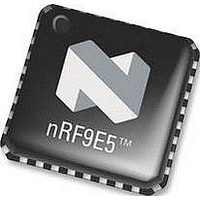NRF9E5 NORDIC SEMICONDUCTOR, NRF9E5 Datasheet - Page 86

NRF9E5
Manufacturer Part Number
NRF9E5
Description
TRX, 430-928MHZ, MCU/ADC/PWM, SMD
Manufacturer
NORDIC SEMICONDUCTOR
Datasheet
1.NRF9E5.pdf
(108 pages)
Specifications of NRF9E5
Receiving Current
12.5mA
Transmitting Current
30mA
Data Rate
50Kbps
Frequency Range
430MHz To 928MHz
Modulation Type
GFSK
Rf Ic Case Style
QFN
No. Of Pins
32
Supply Voltage Range
1.9V To
Lead Free Status / RoHS Status
Lead free / RoHS Compliant
Available stocks
Company
Part Number
Manufacturer
Quantity
Price
Company:
Part Number:
NRF9E5C
Manufacturer:
NORDIC
Quantity:
5 000
Part Number:
NRF9E5C
Manufacturer:
NORDIC
Quantity:
20 000
PRODUCT SPECIFICATION
nRF9E5 Single Chip Transceiver with Embedded Microcontroller and ADC
18.9.2 Mode 1
Mode 1 provides standard asynchronous, full-duplex communication, using a total of ten
bits: one start bit, eight data bits, and one stop bit. For receive operations, the stop bit is
stored in RB8. Data bits are received and transmitted LSB first.
18.9.2.1 Mode 1 Baud Rate
The mode 1 baud rate is a function of timer overflow. Serial port can use either Timer 1
or Timer 2 to generate baud rates. Each time the timer increments from its maximum
count (0xFF for Timer 1 or 0xFFFF for Timer 2), a clock is sent to the baud-rate circuit.
The clock is then divided by 16 to generate the baud rate. When using Timer 1, the
SMOD bit selects whether or not to divide the Timer 1 rollover rate by 2. Therefore,
when using Timer 1, the baud rate is determined by the equation:
SMOD is SFR bit PCON.7
When using Timer 2, the baud rate is determined by the equation:
To use Timer 1 as the baud-rate generator, it is best to use Timer 1 mode 2 (8-bit counter
with auto-reload), although any counter mode can be used. The Timer 1 reload value is
stored in the TH1 register, which makes the complete formula for Timer 1:
The 4 in the denominator in the above equation can be obtained by setting the T1M bit
in the CKCON SFR. To derive the required TH1 value from a known baud rate (when
TM1 = 0), use the equation:
You can also achieve very low serial port baud rates from Timer 1 by enabling the
Timer 1 interrupt, configuring Timer 1 to mode 1, and using the Timer 1 interrupt to
initiate a 16-bit software reload. Table Table 72 lists sample reload values for a variety
of common serial port baud rates.
Main office: Nordic Semiconductor ASA - Vestre Rosten 81, N-7075 Tiller, Norway -Phone +4772898900 - Fax +4772898989
Revision: 1.3
Baud Rate =
Baud Rate =
Baud Rate =
TH1 = 256 -
2
Page 86 of 108
2
SMOD
32
SMOD
32
Timer
128
x Timer 1 Overflow
x
2
SMOD
2
4
Baud
16
Overflow
x
(256
clk
clk
Rate
-
TH1)
June 2006













